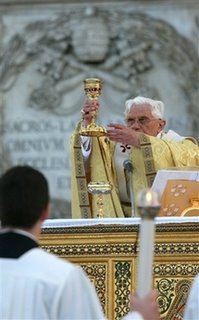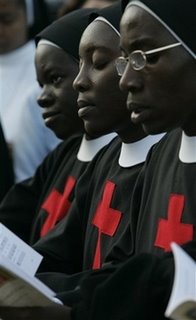 Truly, truly, I say to you, unless you eat the flesh of the Son of man and drink His blood, you have no life in you; he who eats My flesh and drinks My blood has eternal life, and I will raise him up at the last day."-- John 6:53, 54
Truly, truly, I say to you, unless you eat the flesh of the Son of man and drink His blood, you have no life in you; he who eats My flesh and drinks My blood has eternal life, and I will raise him up at the last day."-- John 6:53, 54
On Corpus Christi, we remember and again celebrate this true and lasting miracle. Think about it, we can receive the flesh and blood of Our God! We can truly receive our Creator in a way so that we might have life within us! The Institution of the Eucharist changed the world. We must contemplate this miracle before receiving Our Lord at every single Mass. How can we not share the sentiments of Archbishop Sheen who said, "The greatest love story of all time is contained in a tiny, white Host."
Dom Gueranger writes, "A great solemnity has this day risen upon our earth: a feast both to God and to men: for it is the feast of Christ the Mediator, who is present in the sacred Host, that God may be given to man, and man to God. Divine union—such is the dignity to which man is permitted to aspire; and to this aspiration God has responded, even here below, by an invention which is all of heaven. It is to-day that man celebrates this marvel of God’s goodness."
History of the Feast of Corpus Christi
The Feast of Corpus Christi was instituted in the 13th Century to commemorate the Institution of the Eucharist. While we remember this on Holy Thursday, we also remember Christ's coming passion and death as well as the institution of the priesthood. For the sublime gift of the Holy Eucharist, we need another day set aside just to praise God for His unlimited humility and love. Imagine that bread and wine become the God of Heaven and Earth!
Around the early 1200s, Saint Juliana of Mont Cornillon received a vision concerning this feast at a young age. St. Juliana always had a strong devotion to the Blessed Sacrament. In her vision, she saw the Church under the appearance of the full moon. One large, dark spot was in the moon - symbolic of the absence of a solemnity to honor the Holy Eucharist. St. Juliana became an Augustinian nun in Liége, France, in 1206. Corpus Christi became a feast for the Diocese of Liege in 1246, and later in 1264, after having seen the Eucharistic Miracle in Orvieto, Pope Urban IV issued “Transiturus de hoc mundo” establishing it as a feast for the Universal Church. Pope Urban IV's order was confirmed by Pope Clement V in the Clementines Laws and promulgated by his successor, Pope John XXII in 1317.
In 1970 the name was changed from Corpus Christi to the Solemnity of the Body and Blood of Christ when Corpus Christi and the
Feast of the Precious Blood (July 1) were joined. The feast of the Most Precious Blood of Our Lord was suppressed in the Novus Ordo when the new calendar was promulgated in 1969, and not twenty-plus years later when Corpus Christi was renamed in the USA. The reason for its suppression was the alleged promotion of the understanding of Corpus Christi in terms of both Sacred Species. However, this is highly unfortunate because the feast of the Precious Blood (still observed at all Masses said according to the Liturgical Books of 1962 or previously) was not, strictly speaking, eucharistic in nature, but theological/devotional, and referred more to the Sacred Wounds of Our Lord and the hypostatic union of Our Lord's divine and human natures. The Feast of Corpus Christi has always honored the fullness of Christ - Body, Blood, Soul, and Divinity - in the Eucharist. This is just another reminder of why we should stay clear of the Novus Ordo and remain attached to the Church's Traditional Calendar.
Additionally, up until changes to the Roman Calendar in 1955 by Pope Pius XII, today's feast had an Octave associated with it.
Corpus Christi as a Holy Day of Obligation
The first catalog of Holy Days comes from the Decretals of Gregory IX in 1234, which listed 45 Holy Days. In 1642, His Holiness Pope Urban VIII issued the papal bull "Universa Per Orbem" which altered the required Holy Days of Obligation for the Universal Church to consist of 35 such days as well as the principal patrons of one's locality. Corpus Christi was included in that list from 1642. It had not previously been in the list from 1234 since it was not established until after that time. By the 15th century, Corpus Christi became one of the Church's principal feasts and was likely added as a Holy Day of Obligation around that time.
Corpus Christi is still a Holy Day of Obligation in many countries. The United States
received permission to transfer the celebration of the Mass to the Sunday after Corpus Christi in 1885 by Pope Leo XIII, in a concession to the modern world. This permission remains; however, those who pray the Divine Office will keep the Divine Office on Thursday.
3 Purposes for Today's Feast
1) To honor Our Lord, who is truly present in the Holy Eucharist
2) To instruct others on the faith, mystery, and devotion concerning the Holy Eucharist
3) To show our appreciation for the great gift of the Holy Eucharist
Eucharistic Processions
Many parishes will have
Eucharistic processions. These processions are endowed with indulgences by Pope Martin V and Pope Eugene IV.

















